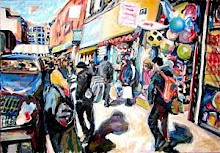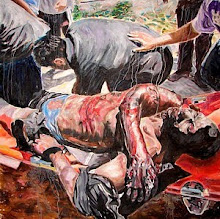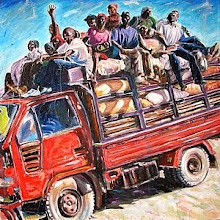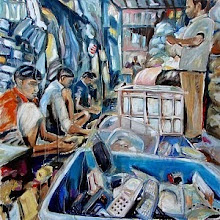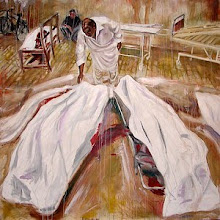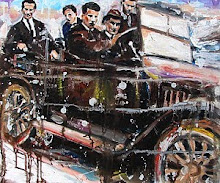A list of books, authors and videos on globalisation, the global economy and the New World Order.
*********************************************
Paul Grignon
Paul Grignon's 47-minute animated presentation of "Money as Debt" tells in very simple and effective graphic terms what money is and how it is being created
Money As Debt (5 parts)
http://www.youtube.com/watch?v=vVkFb26u9g8
http://www.youtube.com/watch?v=sanOXoWl0kc
http://www.youtube.com/watch?v=kTv1fo6sKmo
http://www.youtube.com/watch?v=3qicabStQkc
http://www.youtube.com/watch?v=7kpSbkaD4tM
*********************************************
American Casino
American Casino /Trailer
http://www.youtube.com/watch?v=6VdqiUzKW-c
*********************************************
Noam Chomsky
Books
Hegemony or Survival : America's Quest for Global Dominance
Media Control: The Spectacular Achievements of Propaganda
Manufacturing Consent: The Political Economy of the Mass Media
Video
http://www.youtube.com/watch?v=Zh7ps1KWl_M
*********************************************
Michael Rowbotham
Book
The Grip of Death: A Study of Modern Money, Debt Slavery and Destructive Economics
*********************************************
Ellen Hodgson Brown
Book
The Web of Debt: The Shocking Truth About Our Money System And How We Can Break Free
Video
Web of Debt - Ellen Brown - (5 parts)
http://www.youtube.com/watch?v=QU0XiklHPMc
http://www.youtube.com/watch?v=3_ZbEVfKJ1w
http://www.youtube.com/watch?v=g2EY6enOz74
http://www.youtube.com/watch?v=kPmPLmtreAU
http://www.youtube.com/watch?v=mHm_rtTwNYA
*********************************************
Free Documentaries
http://freedocumentaries.org/index.php
At Freedocumentaries.org, you can stream interesting and provocative documentary films for free
AMERICA: FREEDOM TO FASCISM
Join Aaron Russo as he explores the connection between income tax collection and the erosion of civil liberties in America.
http://freedocumentaries.org/theatre.php?filmid=199&id=1111&wh=1000x720
*********************************************
Michel Chossudovsky
Book
The Globalization of Poverty and the New World Order
Video
http://www.youtube.com/watch?v=qYcYaVs1-aM
*********************************************
Research / News
http://globalresearch.ca/
The Centre for Research on Globalisation (CRG) is an independent research organization and media group of writers, scholars, journalists and activists.
*********************************************
Michael Hudson
Book
Super Imperialism - New Edition: The Origin and Fundamentals of U.S. World Dominance
Video
michael hudson America: Host or Parasite?
http://www.youtube.com/watch?v=Ertii-36Rzs
http://www.youtube.com/watch?v=3pwAFohWBL4
http://www.youtube.com/watch?v=UAVy9F95kNg
*********************************************
Gerald Celente
Video
http://www.youtube.com/watch?v=46MEqEgdLTg
obamageddon
http://www.youtube.com/watch?v=_18t2_XvZRA
4 parts
http://www.youtube.com/watch?v=dDkxwVBbUV4
http://www.youtube.com/watch?v=M_QmRphWw0Y
http://www.youtube.com/watch?v=nuPUojH965s
http://www.youtube.com/watch?v=lpk7SDJ47MI
http://www.youtube.com/watch?v=XjQ-854uBUc
*********************************************
Ward Churchill
Books
On the Justice of Roosting Chickens: Consequences of American Conquest and Carnage
A Little Matter of Genocide: Holocaust and Denial in the Americas 1492 to the Present
Video
http://www.youtube.com/watch?v=p5nba4_x-J8
*****************************************
Howard Zinn
Book
A People's History of the United States: 1492-Present
Video
http://www.youtube.com/watch?v=Arn3lF5XSUg
*********************************************
Michael Parenti
Book
Democracy for the Few
Video (9 parts)
http://www.youtube.com/watch?v=0a9VnxZEHGg
http://www.youtube.com/watch?v=_97_EHQBVgg
http://www.youtube.com/watch?v=EdiPnvYLvWM
http://www.youtube.com/watch?v=v-D24ZEae5o
http://www.youtube.com/watch?v=Ir3WKY4pJE4
http://www.youtube.com/watch?v=wEEdcDWFr_0
http://www.youtube.com/watch?v=p_kl5qUA0LM
http://www.youtube.com/watch?v=hjr2A3zea7A
http://www.youtube.com/watch?v=jo-5PoipGnA
*********************************************
United States public debt
http://en.wikipedia.org/wiki/United_States_public_debt
*********************************************
William Engdahl
Books
A Century of War: Anglo-American Oil Politics and the New World Order
Full Spectrum Dominance: Totalitarian Democracy in the New World Order
Seeds of Destruction: The Hidden Agenda of Genetic Manipulation
Video
http://www.engdahl.oilgeopolitics.net/index.html
http://www.youtube.com/watch?v=xLuJNYW6AtU
Economic crisis ten years of hell?
http://www.youtube.com/watch?v=HsmzfDKPzMs
http://www.youtube.com/watch?v=VuNZCt4HtiI
http://www.youtube.com/watch?v=LVhVr3jU2NM
http://www.youtube.com/watch?v=Toz0n9l-WDg
*********************************************
Anthony Sutton
Books
WALL STREET AND THE RISE OF HITLER
http://reformed-theology.org/html/books/wall_street/index.html
WALL STREET AND THE BOLSHEVIK REVOLUTION
http://reformed-theology.org/html/books/bolshevik_revolution/index.html
*********************************************
Democracy Now
http://www.democracynow.org/
A daily TV/radio news program, hosted by Amy Goodman and Juan Gonzalez, airing on nearly 800 stations, pioneering the largest community media collaboration in the U.S.
Subprime Loan Officer
http://www.democracynow.org/2009/8/28/former_wells_fargo_subprime_loan_officer
Former Wells Fargo Subprime Loan Officer: Bank Targeted Black Churches as Part of Predatory Subprime Lending Scheme
Jacobson-web
Up until two years ago, Elizabeth Jacobson was the top producing loan officer in the subprime division at Wells Fargo. Today she is speaking out against the practices of her former company. Earlier this summer, she filed a sworn affidavit with a federal court in support of the city of Baltimore’s lawsuit against Wells Fargo for pushing high-interest, subprime loans onto African Americans in Baltimore and the Maryland suburbs, leading hundreds into foreclosure.
Sunday, August 30, 2009
Wednesday, February 25, 2009
Dream Scene - Gangs of New York

While watching Gangs of New York a few nights ago I noticed an extraordinary mise-en-scène shot that really struck me for its compact way of creating a mini narrative within the framework of the main narrative. In one long shot the story of many Irish men was told, from their arrival in America to their tragic end in the land that they had hoped would fulfil all their hopes and dreams.
Gangs of New York is a 2002 American historical crime film set in the mid-19th century in the Five Points district of New York City. It was directed by Martin Scorsese and written by Jay Cocks, Steven Zaillian and Kenneth Lonergan. The film is loosely inspired by Herbert Asbury's 1928 nonfiction book The Gangs of New York. It was distributed by Miramax Films and was nominated for numerous awards, including the Academy Award for Best Picture. (wikipedia.org)
The film begins in 1846 and quickly jumps to the early 1860s. The two principal issues of the era in New York were Irish immigration to the city and the Federal government's execution of the Civil War. The story follows Bill "The Butcher" Cutting (Daniel Day-Lewis) in his roles as crime boss and political kingmaker under the helm of Boss Tweed (Jim Broadbent). The film culminates in a confrontation between Cutting and his mob with the protagonist Amsterdam Vallon (Leonardo DiCaprio) and his immigrant allies, which coincides with the New York Draft Riots of 1863. (wikipedia.org)
An extraordinary mise-en-scène shot that almost serves as a mini film within the film tells the story of the fate of many new arrivals into New York in a time of civil war in America.
Mise-en-scène is an expression used in the theatre and film worlds to describe the design aspects of a production. Stemming from the theater, the French term mise en scène literally means "putting on stage." When applied to the cinema, mise-en-scène refers to everything that appears before the camera and its arrangement – sets, props, actors, costumes, and lighting. Recently, the term has come to represent a style of conveying the information of a scene primarily through a single shot – often accompanied by camera movement. It is to be contrasted with montage-style filmmaking – multiple angles pieced together through editing. Overall, mise-en-scène is used when the director wishes to give an impression of the characters or situation without vocally articulating it through the framework of spoken dialogue, and typically does not represent a realistic setting. (wikipedia.org)

The scene starts with Bill and Amsterdam turning their backs as Bill responds, “Not our future” to the Boss Tweed who has just claimed that they were turning their backs on the future i.e. the political and economic potential of the new immigrants. The camera then pans to the left as the new Irish immigrants who have just got off one ship from Ireland are queuing up at the recruiters harbour table where they are sworn in to the army.
Army Recruiter: That document makes you a citizen, and this one makes you a private in the Union army. Now go fight for your country.
A song is overlaid on the scene sung by a woman with the following lyrics:
Irish Singer: [singing] Well, meself and a hundred more, to America sailed o'er, with our fortunes to be made, so we were thinkin' / When we got to Yankee land, they shoved a gun into our hands / Saying "Paddy, you must go and fight for Lincoln."/ There is nothing here but war, where the murderin' cannons roar, and I wish I was back home in dear old Dublin.
The camera pans following the new recruits as they move on up to one who is changing his Irish cap for a soldiers cap. Others are getting into the uniform in assembly line fashion as another recruiter puts a gun into their hands. They then get into another line fully kitted out moving slowly towards another gangway for the ship that will take them to the war. Two soldiers can be heard conversing:
Irish Immigrant: Where we goin'?
Another Immigrant: I heard Tennessee.
Irish Immigrant: Where's that?
The camera then slowly pans along the new recruits as family members, possibly his wife and daughter, run up to one new soldier. A girl with red hair talks to a another worried- looking soldier. As they start up the gangway another soldier asks:
Irish Soldier: Do they feed us now do you think?
[Earlier in the film new recruits were promised three square meals a day if they joined up]. As they move slowly up the gangway the camera cranes up higher and we can see soldiers sitting around on the ship waiting. Just then a coffin comes into view [with the number 61 stuck to it] as it is lifted with ropes by a crane in the direction of the quays. The coffin flies over the heads of the line of recruits and more coffins come into view for the first time. Soon we see two rows of 10 coffins each neatly laid out and being inspected by soldiers. Two workers carry one of the coffins past the line of new recruits [who don’t seem to notice it] and up the quay presumably to a graveyard. At this point there is a cut to a presentation of Uncle Tom’s Cabin.

This whole mise-en-scène shot lasts one minute and eight seconds.
Historical and political ironies
Of the many ironies in this scene two stand out. In a slightly earlier scene the politician says:
Boss Tweed: That's the building of our country right there, Mr. Cutting. Americans aborning.
They may be new American citizens but the scene on the docks starts with the idea of birth and ends with death symbolised by the rows of coffins revealing the way many immigrants were seen as cannon fodder for a war they knew nothing about. Their basic desires for acceptance and food led them to a fate they were scarcely aware of.
Continuing the above dialogue, Bill, a Protestant, states his view of the Irish bluntly:
Bill: I don't see no Americans. I see trespassers, Irish harps. Do a job for a nickel what a nigger does for a dime and a white man used to get a quarter for. What have they done? Name one thing they've contributed.
Boss Tweed: Votes.
Bill: Votes, you say? They vote how the archbishop tells them, and who tells the archbishop? Their king in the pointy hat what sits on his throne in Rome.
The second irony here is that Bill sees them in religious terms and feels no solidarity or empathy for their plight as victims of British colonial policy back in Ireland despite the fact that Bill’s own father also suffered at the hands of the British:
Bill: My father gave his life, making this country what it is. Murdered by the British with all of his men on the twenty fifth of July, Anno Domini, 1814. Do you think I'm going to help you befoul his legacy, by giving this country over to them, what's had no hand in the fighting for it? Why, because they come off a boat crawling with lice and begging you for soup.
Another irony here is that the Irish immigrants were queuing up to fight and die for their new home despite not knowing very much about the issues involved and had just come off a boat ‘crawling with lice’ and begging for soup. Their lack of awareness is emphasised by the fact that they don’t seem to notice or question the array of coffins on the quay that they are walking past. They seem blissfully unaware that they have jumped from the frying pan into the fire in their relief and excitement of having finally arrived in America.
Of course, Bill was right when he said that the immigrants were not part of his future as the reign of gangs in New York was eventually overtaken by a unified state and built up on the backs of the many immigrants who would pour in for many years to come.
Sunday, February 22, 2009
Thinking spaces
In the last week I have come across two examples of ‘thinking spaces’ while reading Arthur Conan Doyle’s Sherlock Holmes and while watching Andrei Tarkovsky’s Stalker. In the former it appears as the Diogenes Club and in the latter as the Zone.

The Diogenes Club
The Diogenes Club is a fictional gentleman's club created by Sir Arthur Conan Doyle and featured in several Sherlock Holmes stories, most notably "The Greek Interpreter". It seems to have been named after Diogenes the Cynic (although this is never expanded upon in the original stories) and was co-founded by Sherlock's indolent older brother, Mycroft Holmes.
The section reads as follows:
There are many men in London, you know, who, some from shyness, some from misanthropy, have no wish for the company of their fellows. Yet they are not averse to comfortable chairs and the latest periodicals. It is for the convenience of these that the Diogenes Club was started, and it now contains the most unsociable and unclubable men in town. No member is permitted to take the least notice of any other one. Save in the Stranger's Room, no talking is, under any circumstances, allowed, and three offences, if brought to the notice of the committee, render the talker liable to expulsion. My brother was one of the founders, and I have myself found it a very soothing atmosphere. – The Greek Interpreter
Diogenes "the Cynic", Greek philosopher, was born in Sinope (modern day Sinop, Turkey) about 412 BC (according to other sources 404 BC), and died in 323 BC, at Corinth. Diogenes, a beggar who made his home in the streets of Athens, made a virtue of extreme poverty. He is said to have lived in a large tub, rather than a house.

One could describe Diogenes as a bit of a performance artist:
He used to stroll about in full daylight with a lamp; when asked what he was doing, he would answer, "I am just looking for a human being."

When Plato gave Socrates' definition of man as "featherless bipeds" and was much praised for the definition, Diogenes plucked a chicken and brought it into Plato's Academy, saying, "Behold! I've brought you a man." After this incident, "with broad flat nails" was added to Plato's definition.
Alexander found the philosopher looking attentively at a pile of human bones. Diogenes explained, "I am searching for the bones of your father but cannot distinguish them from those of a slave."
Diogenes seems to have led quite a solitary life, thinking, begging and working on ways to make his life ever more simple.

The Zone
Stalker is a 1979 science fiction film directed by Andrei Tarkovsky, and loosely based on the novel Roadside Picnic by Boris and Arkady Strugatsky. It depicts an expedition led by the Stalker (guide) Alexander Kaidanovsky to bring his two clients, the Writer and the Professor, to a site known as "the Zone", which has the supposed potential to fulfill a person's innermost desires.
In an interview on the MK2 DVD, production designer Rashit Safiullin, describes the Zone as a space in which humans can live without the trappings of society, and can speak about the most important things freely. (Wikipedia.org)
Thinking space
The interesting thing about these two variations on a thinking space is the idea of personal fulfillment that can only be achieved by a level of isolation and peace. The difficult part is escaping the trappings of society. In the Diogenes Club this is achieved by setting up a restricted space, a club, and imposing rules of silence. The Zone is only found after running the gamut of military machine gun fire and following the directions of the Stalker. The idea of a thinking space has a lot of significance today with the all-pervading sounds of television and pop radio in every public space, even in banks which in the past were as hallowed as churches.
Not that personal fulfillment is necessarily a selfish idea in relation to society in general. Even Karl Marx had to go the British Library for some peace and quiet to work out his ideas for Kapital. There are many distractions in the world today and having a space to work in without the constant ringing of the phone or the doorbell is a difficult achievement. However, by ignoring the phone and taking the batteries out of the doorbell one can enjoy a certain level of peace and quiet to get down to some real work. It can take some time to calm down and concentrate on the job in hand. One reason for this is that painting, like writing or composing is an intensely intellectual process. Artists are so often portrayed as over-emotional beings who are like wild animals splashing and throwing paint on enormous canvases and mystically ingesting the results before getting into another rage and attacking the canvas with another implement like a roller to achieve the perfect visual representation of their own personal catharsis. (See Woody Allen’s film Vicky Cristina Barcelona for an excellent example)
However, while a certain amount of painting involves dynamic bodily exertions, much of the work consists of imagining what one wants the finished work to look like and then setting out to achieve that through tone, composition and choice of colour. And this is where the concentration comes in, the importance of peace and quiet to think about which colour or tone is more suitable for different sections of the work in progress. Will there be an overall flattening of the tones or will there be depth? Will I emphasise some elements of the design to bring them forward or send them back? Will I break down and abstract some of the elements or keep a level of realism? What am I trying to achieve with the symbols I have chosen to use? How do I use line and brushstroke to retain a level of dynamism without deadening the whole movement of the composition? Eventually the picture starts to take shape and it becomes easier to see where it is going and push it along to its final destination. Having said that, knowing when to stop is of extreme importance too otherwise the fine balance of looking dynamic or muddy is upset.
Philip Guston described the process thus:
Usually I am on a work for a long stretch, until a moment arrives when the air of the arbitrary vanishes, and the paint falls into positions that feel destined.
By giving ourselves the time and space to think out our ideas we achieve a level of self-fulfillment while at the same time allowing us to go back out into society with renewed desire for debate and action in society itself.

The Diogenes Club
The Diogenes Club is a fictional gentleman's club created by Sir Arthur Conan Doyle and featured in several Sherlock Holmes stories, most notably "The Greek Interpreter". It seems to have been named after Diogenes the Cynic (although this is never expanded upon in the original stories) and was co-founded by Sherlock's indolent older brother, Mycroft Holmes.
The section reads as follows:
There are many men in London, you know, who, some from shyness, some from misanthropy, have no wish for the company of their fellows. Yet they are not averse to comfortable chairs and the latest periodicals. It is for the convenience of these that the Diogenes Club was started, and it now contains the most unsociable and unclubable men in town. No member is permitted to take the least notice of any other one. Save in the Stranger's Room, no talking is, under any circumstances, allowed, and three offences, if brought to the notice of the committee, render the talker liable to expulsion. My brother was one of the founders, and I have myself found it a very soothing atmosphere. – The Greek Interpreter
Diogenes "the Cynic", Greek philosopher, was born in Sinope (modern day Sinop, Turkey) about 412 BC (according to other sources 404 BC), and died in 323 BC, at Corinth. Diogenes, a beggar who made his home in the streets of Athens, made a virtue of extreme poverty. He is said to have lived in a large tub, rather than a house.

One could describe Diogenes as a bit of a performance artist:
He used to stroll about in full daylight with a lamp; when asked what he was doing, he would answer, "I am just looking for a human being."

When Plato gave Socrates' definition of man as "featherless bipeds" and was much praised for the definition, Diogenes plucked a chicken and brought it into Plato's Academy, saying, "Behold! I've brought you a man." After this incident, "with broad flat nails" was added to Plato's definition.
Alexander found the philosopher looking attentively at a pile of human bones. Diogenes explained, "I am searching for the bones of your father but cannot distinguish them from those of a slave."
Diogenes seems to have led quite a solitary life, thinking, begging and working on ways to make his life ever more simple.

The Zone
Stalker is a 1979 science fiction film directed by Andrei Tarkovsky, and loosely based on the novel Roadside Picnic by Boris and Arkady Strugatsky. It depicts an expedition led by the Stalker (guide) Alexander Kaidanovsky to bring his two clients, the Writer and the Professor, to a site known as "the Zone", which has the supposed potential to fulfill a person's innermost desires.
In an interview on the MK2 DVD, production designer Rashit Safiullin, describes the Zone as a space in which humans can live without the trappings of society, and can speak about the most important things freely. (Wikipedia.org)
Thinking space
The interesting thing about these two variations on a thinking space is the idea of personal fulfillment that can only be achieved by a level of isolation and peace. The difficult part is escaping the trappings of society. In the Diogenes Club this is achieved by setting up a restricted space, a club, and imposing rules of silence. The Zone is only found after running the gamut of military machine gun fire and following the directions of the Stalker. The idea of a thinking space has a lot of significance today with the all-pervading sounds of television and pop radio in every public space, even in banks which in the past were as hallowed as churches.
Not that personal fulfillment is necessarily a selfish idea in relation to society in general. Even Karl Marx had to go the British Library for some peace and quiet to work out his ideas for Kapital. There are many distractions in the world today and having a space to work in without the constant ringing of the phone or the doorbell is a difficult achievement. However, by ignoring the phone and taking the batteries out of the doorbell one can enjoy a certain level of peace and quiet to get down to some real work. It can take some time to calm down and concentrate on the job in hand. One reason for this is that painting, like writing or composing is an intensely intellectual process. Artists are so often portrayed as over-emotional beings who are like wild animals splashing and throwing paint on enormous canvases and mystically ingesting the results before getting into another rage and attacking the canvas with another implement like a roller to achieve the perfect visual representation of their own personal catharsis. (See Woody Allen’s film Vicky Cristina Barcelona for an excellent example)
However, while a certain amount of painting involves dynamic bodily exertions, much of the work consists of imagining what one wants the finished work to look like and then setting out to achieve that through tone, composition and choice of colour. And this is where the concentration comes in, the importance of peace and quiet to think about which colour or tone is more suitable for different sections of the work in progress. Will there be an overall flattening of the tones or will there be depth? Will I emphasise some elements of the design to bring them forward or send them back? Will I break down and abstract some of the elements or keep a level of realism? What am I trying to achieve with the symbols I have chosen to use? How do I use line and brushstroke to retain a level of dynamism without deadening the whole movement of the composition? Eventually the picture starts to take shape and it becomes easier to see where it is going and push it along to its final destination. Having said that, knowing when to stop is of extreme importance too otherwise the fine balance of looking dynamic or muddy is upset.
Philip Guston described the process thus:
Usually I am on a work for a long stretch, until a moment arrives when the air of the arbitrary vanishes, and the paint falls into positions that feel destined.
By giving ourselves the time and space to think out our ideas we achieve a level of self-fulfillment while at the same time allowing us to go back out into society with renewed desire for debate and action in society itself.
Subscribe to:
Posts (Atom)
